How to Grow Your Own Strawberries
Strawberries offer a quintessential taste of British summertime with their characteristic aroma, bright red colour, juicy texture and sweetness. Strawberry plants are popular for good reason; they are versatile and low cost and with the right care and attention will reliably deliver a delicious crop of home-grown fruit over the summer. Strawberries will grow in the border, growth bags, containers, window boxes or even hanging baskets and make an easy and highly rewarding fruit to grow with children. Buy plants from a reliable supplier to ensure they are disease free and true to variety and before you know it, you and your family will be enjoying the taste of fresh, home grown strawberries.
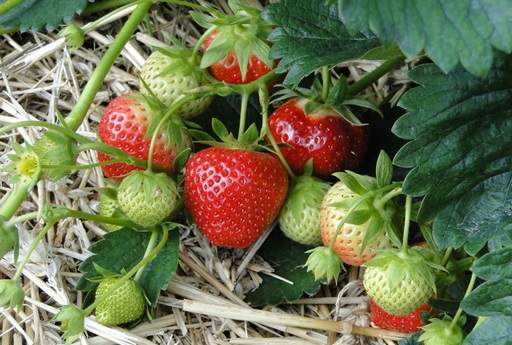
Delicious strawberries
Recommended Strawberry Variety
The best strawberry variety is:
Strawberry Cambridge Favourite - one of the best known varieties of strawberry available offering juicy fruit and an excellent flavour in mid-season. It produces large, bright red fruits which crop heavily, with a flavour that is sweet and juicy. Cambridge Favourite is a reliable cropper, tolerant of a range of soil types and with good disease resistance. The cropping period can be extended or brought forward by keeping them in a greenhouse.
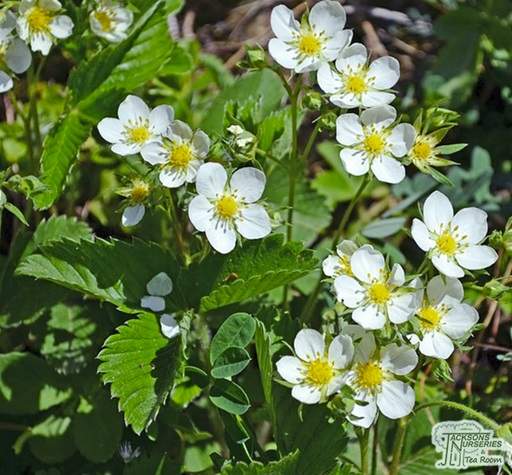
Summer Fruiting, Perpetual and Alpine Strawberries
- Summer-fruiting strawberries - crop heavily over a short period of 2-3 weeks. They are the most popular type of strawberry, available in early, mid and late fruiting varieties (Strawberry Cambridge Favourite is the best mid-fruiting cultivar).
- Perpetual Strawberries ("everbearers")- produce a more modest crop of smaller strawberries compared to summer-fruiting varieties, but in 3-4 flushes during a longer period from early summer to early autumn. Perpetual strawberries do not produce runners and the fruits aren't typically as good, but they are useful for extending the season. Everbearers can be forced to concentrate production in late summer and early autumn by removing early summer flowers.
- Alpine Strawberries ("wild strawberry") - produce lots of very small, elongated, sweet berries from mid-summer through to early autumn. They are not as good as summer-fruiting strawberries for growing domestically; they typically occur naturally along roadsides, hillsides, trails, embankments, stone paths, young woodlands, meadows and clearings.
Fruit
Home grown strawberries are full of flavour and freshness; in fact sweetness, fragrance and complex flavour are consistently favourable attributes of the "ideal" strawberry experience. Strawberries are sweet and well-flavoured when taken straight from the bush (after washing, of course), making them perfect for eating fresh. They are an excellent source of vitamin C, magnesium and several other key vitamins.
Culinary Uses
Home grown strawberries taste delicious - far better than anything you'll find in the shops (strawberries supplied in shops typically come from the Canary Islands or other overseas locations, and they do not travel well). Often the simplest approach is the best - strawberries eaten fresh with a little sugar or cream, as famously consumed at Wimbledon. Other great desserts include strawberry pie, strawberry rhubarb pie, strawberry cheesecake, tiramisu and strawberry and mascarpone tart (impressive for dinner parties).

Alternatively, strawberries are the essential ingredients for many popular dairy products: strawberry ice cream, strawberry milkshake, strawberry smoothies and strawberry yoghurts. Soft set strawberry jam is easy to make and strawberry juices and cocktails also cannot be ignored. Strawberries do not freeze well and only keep for around 2 days in the fridge, so they're best eaten fresh or dried and used to add a fruity twist to cereal such as bran flakes if you harvest more than you can eat straight away.
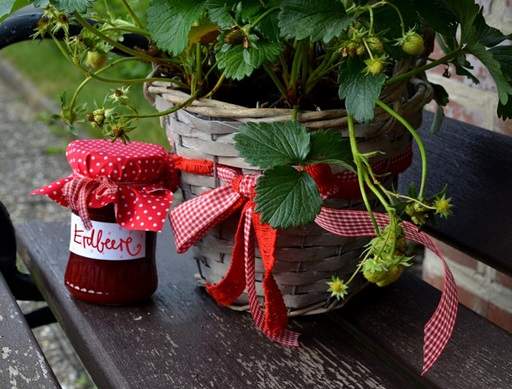
Planting Advice
When to Plant
Strawberry plants supplied in pots can be planted from late spring onwards, although we would recommend avoiding winter as the ground is typically too cold or too wet. Planting in early autumn works well as this gives your strawberry plants plenty of time to establish themselves during the winter. Typically, the later planting is carried out in the autumn, the smaller the maiden crop will be the following year. Alternatively, strawberries can be planted in spring or summer, although if you opt for this approach it's best to remove the first flowers to allow yours plants to invest their energy into proper establishment, then wait a year for your first fruits.
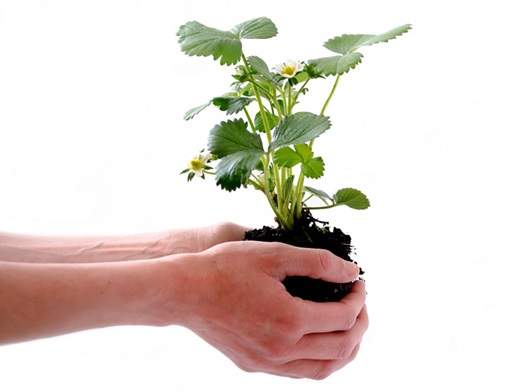
Soil
Strawberries prefer a fertile, well-drained soil, ideally in a very slightly acidic ground. They're not too fussy about acidity but have a fine, fibrous root system so will not survive for long if left lying in soggy, water-logged conditions. In poor or heavy clay soils, either grow strawberries in raised beds to improve the drainage, allow for greater rooting depth and to allow the roots to warm up more quickly in the spring, or opt for grow bags instead. It's also a good idea to grow your strawberry plants through polythene to help suppress weed growth and improve moisture retention in the summer.
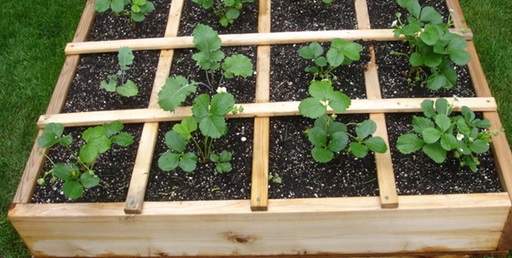
Strawberries grown in a raised bed
Ideally, cultivate the ground around 4 weeks before planting. Strawberries do not produce deep roots, but appreciate soil that has been well-dug to a spades' depth with any rocks or hard layers of soil removed. When preparing the ground, remove perennial weeds and incorporate plenty of well-rotted bulky organic matter such as horse manure or garden compost, along with two generous handfuls of bonemeal, to provide nutrition (this is best done in advance of planting to allow it to settle).
Top Tip: Do not plant strawberries where you have previously grown peppers, eggplant, tomatoes, potatoes or chrysanthemums as they are prone to verticillium wilt which, if still in the ground, will likely spread to your strawberry plants. Potatoes left in the ground can also be a problem and getting rid of them may interfere with the roots of your strawberry plants. We also discourage growth of strawberries on ground that has recently had grass growing over it as there may be wireworms in the soil who will indulge on your strawberries before you harvest them.
Position & Aspect
Strawberry plants prefer full sun during the major growing period; they will succeed in dappled shade but tend to be less prolific. Select a sheltered position protected from frost pockets and cold or strong winds - north-facing sites are best avoided and windy sites will prevent pollinating insects from reaching the flowers. Strawberries are hardy plants during the winter but are not so hardy when they burst into life in spring, so the more protection, the better. Strawberries are ideal fruit for benefiting from the use of cloches to produce earlier and better fruit. This is particularly encouraged in colder part of the UK further north but can also be used in the warmer south to bring forward the harvest date by a week of two. Install the cloche in March and remember to open the clothe or raise the sides of the polythene on sunny days once the flowers have opened to allow bees and other insects to pollinate the flowers. If this is not done, the fruit set is likely to be poor.
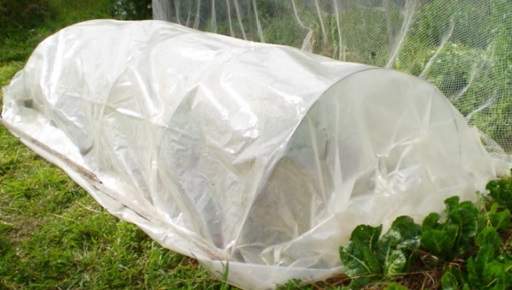
Strawberries grown under a cloche
Alternatively, growing strawberry plants in an outhouse, conservatory, greenhouse or polytunnel will bring forward the flowering and therefore fruiting phase by up to 2 weeks. This should be unheated in all but the very coldest parts of the UK as if temperatures excess 16 degrees inside the greenhouse in the spring, this will prohibit flowering. If you intend to keep strawberries indoors, it's best to plant them in separate pots using multi-purpose compost. Flowers will also need to be hand pollinated. This is easily achieved by gently brushing a soft paint brush around the central yellow part of each of the flowers.
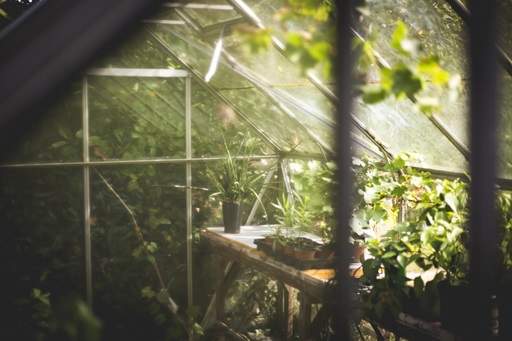
On warm, sunny days when the temperature rises above 16 degree, adequate ventilation should be provided. With a cloche or cold frame this may involve removing some of the panels or opening the vents, or by raising the sides if you're using a polythene cover. The cover should be replaced or the vents closed in mid-afternoon. When ventilation has to be given during cropping, the gaps should be covered with netting to prevent birds from eating the fruit.
Spacing
Plant strawberries 30cm apart with 75cm between rows if growing out in the garden. Choose a suitable formation to maintain roughly 30cm spacing if growing in a container. Spacing can be reduced if growing in a container which will allow your strawberry plants to trail out over the sides.
Planting
Firstly, ensure you've selected an appropriate position in line with the guidance above and that the soil/compost is moist before planting. Prepare a hole large enough to accommodate the roots using a trowel, then remove your strawberry plant from its pot, gently tease out the roots from the rootball and spread them out in the planting hole. The planting hole should be sufficiently deep such that the roots do not need to curl upwards in the hole. If the roots are too long to plant easily in this way, they can be cut back to no less than 10cm (4 inches) in length using secateurs. It's essential your strawberries are planted at the correct depth: too deep and they will rot; too shallow and your plants will dry out. This is easy if growing pot-grown strawberry plants as you just need to ensure the top of the compost is in line with the soil surface. When planting strawberry runners, the base of the crown should be positioned just above the soil surface. If severe winter frosts cause your strawberry plants to be raised out of the ground slightly, they should be pushed back in or better still planted back into the trench at the correct depth.
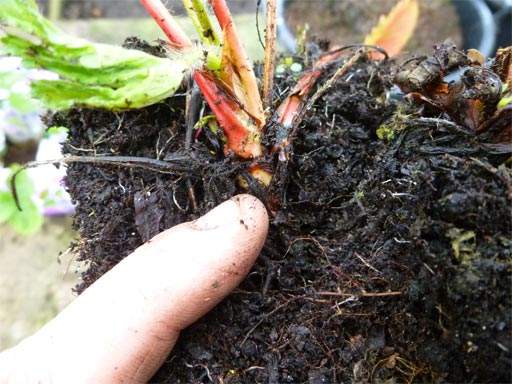
Crown of a strawberry plant, which should be positioned just above the soil surface
Backfill carefully, keeping the soil off the crown and removing any large stones that may damage the roots as you do so, then gently firm around your strawberry plants using fingertips or the trowel to eliminate air pockets. To test whether you've firmed your strawberry plants in well enough, attempt to pull them out of the soil by one of their leaves; if the plant moves before the leaf tears, you have not planted in firmly enough.
Weed suppression is an important consideration for strawberry plants, which should start at the planting phase. Consider planting your strawberries through polythene to help suppress weeds and maintain ground temperature on cooler evenings. This technique has the added benefit of helping to maintain discrete strawberry plants since 'runners' will not be able to root through the plastic.
To do this, once you've prepared your ground, lay over a sheet of polythene and secure it using metal hoops that can be fashioned from short pieces of wire.

Preparing the site to plant strawberries through black polythene
If planting through black polythene, the size of the slits you plant through is an important consideration: too small and your strawberry plants' growth will be restricted; too large and weeds can be a problem. An 8cm (3 inch) diameter hole is a good compromise. A good alternative is to place fibre mats under each strawberry plants after it's been placed in the ground; these will also serve as a weed barrier and protect your strawberries from touching the ground.
Growing Strawberries in a Grow Bag
If you decide to grow strawberries in a grow bag, choose one that is good quality and recommended for growing tomatoes. Grow bags are best planted in spring or summer with potted strawberry plants. Position your grow bag against a wall to improve drainage and to allow it to be raised slightly, away from potential pests. The first important step is to cut drainage holes at the base of the bag, then holes in the side of the bag where your plants will go (we find cutting an "x" shape works best for the latter). Bed your strawberry plants firmly into the grow bag compost and to maximise your yield from a single bag pop a couple of plants in at the top also. We do not recommend putting more than 8 plants in a 1m bag. Water well after planting and follow all other instructions and guidance as for plants grown in the open ground.
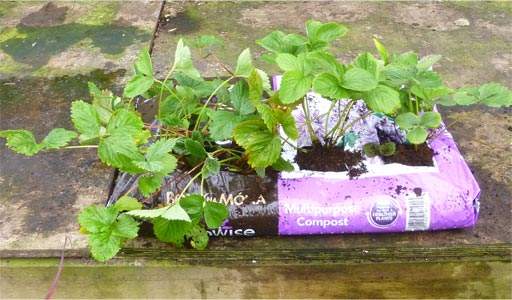
Growing strawberries in a grow bag
Container Growing Strawberry Plants
Strawberries are versatile and well suited to growing in patio containers, planters or hanging baskets as they have a shallow root system. Basically any container is fine providing it has sufficient room for the roots and adequate drainage holes. Planting strawberries in a container has the added benefit of preventing the fruits from lying on the ground, so they are protected from snails, slugs, vine weevil and small mammals. Drainage is also readily improved by placing the pot/planter on 'feet' and planting with a 2.5-5cm (1-2 inch) layer of pebbles, gravel or stone at the base to ensure your strawberry plants don't lie sodden.Use a loam-based potting compost such as John Innes No 2 or multi-purpose compost with some water retaining gel and slow-release fertiliser granules mixed in.
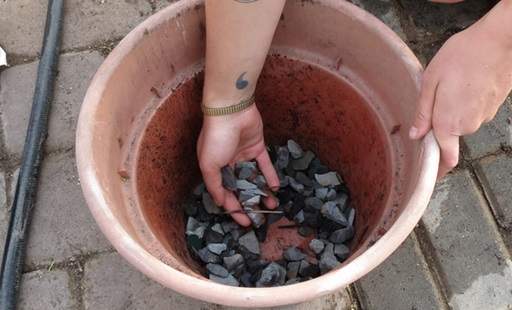
Position 2.5-5cm of pebbles, gravel or stone at the base of your strawberry growing container
When planting strawberries in a container, don't try to squeeze too many in as they will compete for light, resulting in a weaker crop, and the strawberries produced may end up laying on top of one another. Ensure roots are well spread out across the container when planting up, backfill and firm down the soil using your fingers or trowel. It's a good idea to put a layer of stones on the top of the soil, so when watering the soil is not splashed onto the fruits. Plant into moist compost and water well after planting. Position your container somewhere in full sun with protection from prevailing winds.
Container-grown strawberry plants benefit from being repotting with fresh compost every year. This is best done in early spring as they are starting to show first signs of growth. Remove them from the pots, comb out as much of the old compost as possible, prune away 10% of the root system and replant with fresh compost.
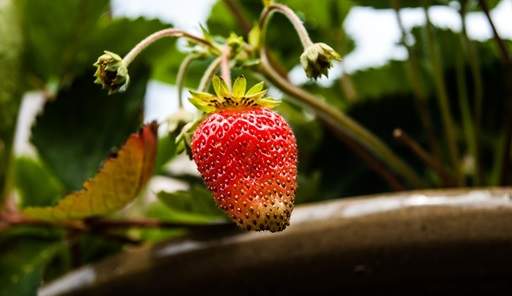
Strawberry plants grown in containers
Garden Care
Growing strawberries is easy - producing and protecting a good crop of fruits is a little more challenging!
Feeding
Strawberries are greedy feeders over a relatively short period of time as the fruits are produced.In early spring provide a generous sprinkling of a slow-release, multi-purpose granular feed around the base of your strawberry plants to set them up for the growing season ahead. Follow this with a fortnightly application of a high-potassium liquid feed such as tomato food, to encourage an abundant crop of good quality fruit. Strawberry plants should not be given high nitrate feed until the vigour visibly declines, otherwise this will encourage excessive foliage growth at the expense of the fruit. For strawberries newly planted into a grow bag, container or hanging basket in the spring, nutrients mixed into the compost should be sufficient to provide satisfactory growth until the plants come into flower. At this stage, the fortnightly high-potassium liquid feed can commence. Feeding should cease each year at the end of September.
Caring for fruit on your strawberry plants
As strawberries hang down from the plant onto the surrounding ground, they are liable to rot or be consumed by pests such as slugs unless they are raised up from the earth. Plants established on the flat that have not been grown through polythene or had fibre mats placed around them should have straw laid under the developing fruit trusses to prevent them from making contact with the soil and keep them clean. Barley straw is best because it is soft and pliable. This will reduce the incidence of fruit rot. If for any reason, your strawberry plants are growing weakly (and in the first summer after planting if you planted in spring), the flowers should be cut off to enable the strength of the crowns to be built up for the following year's crop.
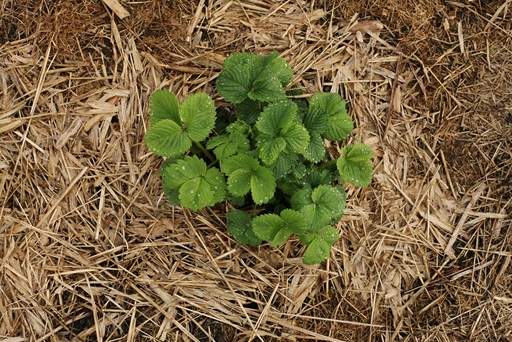
Harvesting
Most strawberries mature in mid-summer and should be picked when fully ripe (bright red) at which stage they will have fully developed their flavour, sweetness and aroma. Pick at the warmest part of the day as this is when their sugar levels are highest and the fruit the most tasty. Pick your strawberries using a shallow container; if you use a deep one, the lower fruits will be squashed and bruised by the weight of the fruit above. To pick a strawberry, take the stalk between your thumb and forefinger and gently sever using your nails, being careful not to bruise the flesh. You should be able to do this such that the fruit gently rests straight in your collection container, without being touched or bruised. Strawberries should always be picked with the calyx (green stem) attached, so don't attempt to rip the fruit out from the calyx straight off the plant.
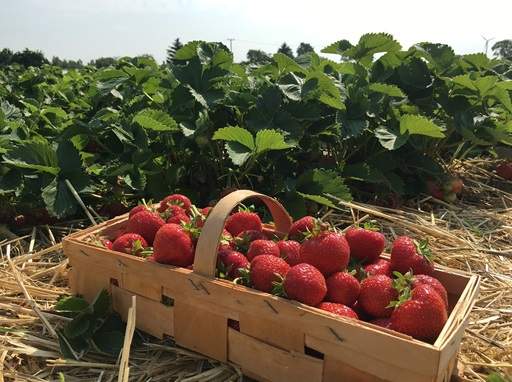
Expose strawberry plants to the winter frost by taking them out of the greenhouse or removing the cloche once fruit production has finished. Strawberry crowns that are exposed to the winter cold will typically fruit better the following year.
Cutting back foliage and tidying your strawberry plants after fruiting
When the harvest is over, remove the straw mulch to prevent it from harbouring any pests and diseases. Also cut away the old foliage to within 10cm (3-4 inches) of the crown of the plant. Old foliage will by now be looking tired and likely starting to become vulnerable to pests and diseases. This can be done with a pair of secateurs, shears or a carefully used bill hook. By removing the old foliage, pests and diseases will automatically be taken away, the young leaves at the crown of the plant will get a better chance to grow and develop and air circulation around your plants will be improved.
Strawberry Plant Runners
Strawberry plants start producing runners in June following flowering. Runners are the spaghetti-like stems emanating from each strawberry plant from which new baby plants could develop in the summer. Runners can be used as a great way to obtain new strawberry plants; however, they drain the 'mother' strawberry plants of their energy, resulting in a significantly weakened fruit production (if any at all). If you'd like to use runners to propagate some new strawberry plants, we recommend using roughly 4 out of every 5 plants you grow for fruit production (remove the runners) and 1 out of every 5 plants you grow for propagation (as below).
Removing Runners - Using an old pair of secateurs or a sharp knife, remove the runners right back to their point of origin as soon as they appear.
Propagating New Plants from Runners - When runners appear, peg a maximum of 2 per mother plant down to the ground to encourage them to take root. By the next April, the baby plant should have grown 3-4 leaves and developed a small root system of its own. At this point, the baby plant can be severed from the mother plant (by cutting the runner), briefly placed in water and re-potted separately in multi-purpose compost.
Watering
Water well after planting and particularly from first fruit swelling. Regular watering is all the more important for strawberry plants grown in containers as they will dry out quickly during periods of hot summer weather. Check the compost daily during periods of drought and water if the top 1.5cm (half inch) of compost feels dry. Using your watering can gently water near but not over your strawberry plants. Moisture is vital during fruit formation, especially if growing in containers, but strawberry plants also do not like to lie wet, so it's equally important to follow the guidance for good drainage detailed above. The moisture content should be increased as the plants expand and the temperature rises but not to the extent of allowing the compost to become saturated. If your strawberry plants are already flagging as a result of drying out, the containers should be temporarily shaded, to allow the plants to recover. Reduce watering to a bare minimum after about 4 weeks when growth shows signs of slowing down; this is usually when the leaves begin to show autumn tinges.
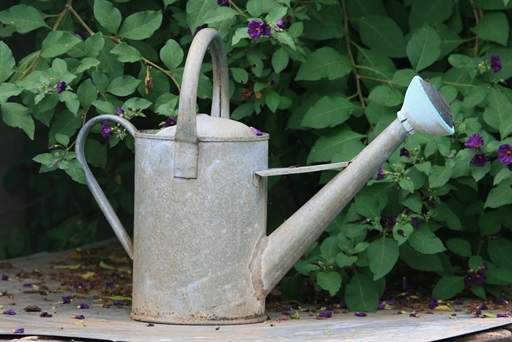
Frost Protection
Late spring frosts can seriously reduce your strawberry crop. The best way to prevent frost damage is to cover your plants with horticultural fleece, straw or polythene sheets. This should be installed during the daytime and replaced in the evening if required.
Strawberry plants have a 3 year cycle - in the first year you'll get a modest crop, in the second and third years you'll get a large crop, but thereafter they lose their vigour, yield smaller crops and become more vulnerable to pests and diseases. For this reason, it is widely recommended that strawberry plants are replaced every 3 years, or sooner if there are signs of disease. This is best done as part of a crop rotation system, if space within your garden permits, because diseases that attack one plant variety might not attack another. If possible, plant strawberries into places where turnips, cauliflowers or cabbages have grown previously, as these other crops tend to suppress weed growth, which is very important for strawberries to succeed. Broad beans and peas are other suitable preceding crops as they are harvested in midsummer so allow strawberries to be planted early.
Three-Yearly Strawberry Plant Replacement
It's actually a good idea to adopt a rotation system which involves a small number of new strawberry plants being started every year, to ensure a succession of fruit from year to year. By adopting this approach, you'll reduce the risk of your strawberry and other vegetables being affected by pests and diseases and will never need to go without.
Problems
It's worth keeping a close watch for early signs of pest and disease attack as strawberry plants can fall victim to a number of things. Some of the key ones to look out for and solutions if they strike are detailed below:
- Botrytis- affects strawberries grown in the greenhouse where conditions are very humid. It is characterised by a fussy grey mould. Remove all affected parts of your plants as soon as it is discovered. Reduce the likelihood of botrytis developing by maintaining a tidy plant area and mulching with straw to prevent foliage, flowers and fruit from making contact with the compost.
- Powdery Mildew - a fungal disease characterised by a white powdery coating on top of leaves. Promptly remove affected foliage and consider using a fungus spray. Ensure compost is always kept moist but avoid water from making contact with the leaves of your strawberry plants. Follow spacing recommendations and ensure greenhouses are well ventilated to ensure good through-flow of air around your plants.
- Birds - strawberries are different to most other fruits in that they produce their seeds on the outside of the fruit. Combined with their bright red colouration when ripe, this has the unfortunate side-effect of making them very attractive to birds who adore ripening fruit and will eat all the fruits of your hard earned labour over just a few days if they're allowed to. To prevent birds from stealing your crop, install netting over your plants just as (or if possible before) the berries start developing. Make sure netting is pulled and secured taut above your strawberry plants; if netting is only loosely draped over your plants, birds will likely still be able to get to the fruits. If you're growing a large number of strawberry plants in rows out in the garden, a fruit cage over the patch may be the best solution. A simple net tunnel over a row of strawberries is easy to install.
- Vine Weevil- beetles may nibble at the edge of leaves, but what causes more serious damage is the white larvae that feed on the roots and can kill strawberry plants if not caught early. The best solution is to spray plenty of bug killer onto the compost around your strawberry plants.
- Snails and Slugs - If slugs or snails are a problem, check your straw is nice and snug around each plant. If the problem persists, use things like coffee grounds or crushed egg shells or copper slug rings placed around each plant. If you decide to use slug pellets, opt for one that is approved for organic use.
Share this page:

